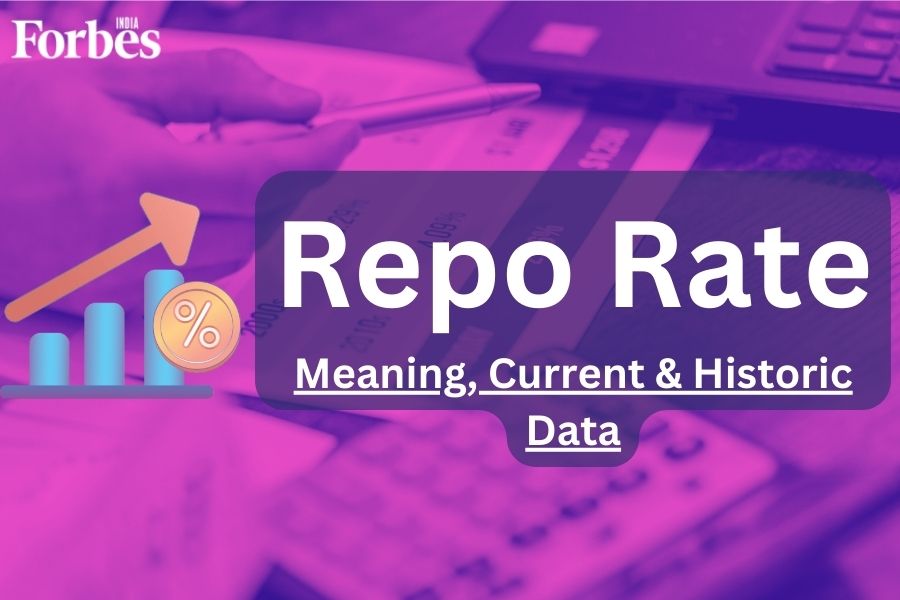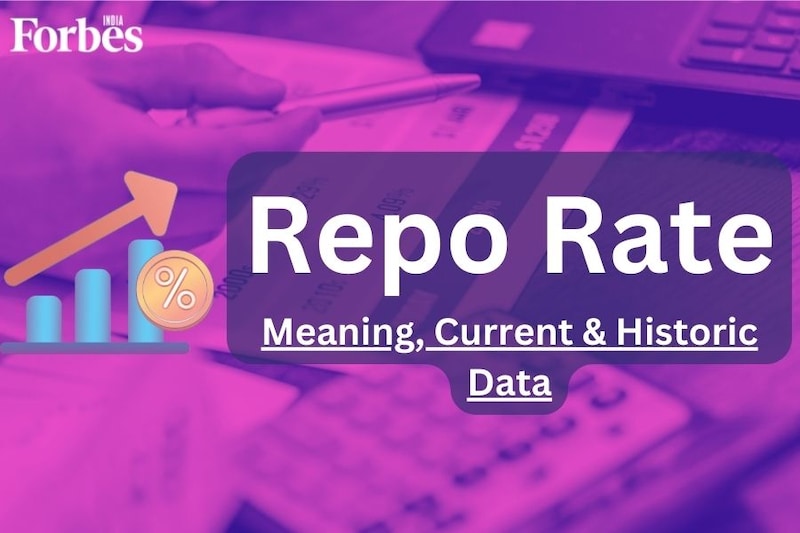
When it comes to handling a country’s economy and financial markets, one crucial tool may be found in monetary policy. The repo rate—short for “repurchase rate”—is the name given to this instrument. The repo rate is a benchmark interest rate used by the Reserve Bank of India (RBI) to facilitate the smooth operation of the monetary system.
The word “repo rate” appears frequently in banking and monetary policy conversations. It refers to the interest commercial banks pay to RBI for overnight loans secured by those securities.
The repo rate is essential for the RBI to manage money in the economy. By adjusting the repo rate, the RBI can influence how much it costs for banks to borrow money, affecting the interest rates for loans and savings. Several aspects of the economy are sensitive to changes in the repo rate, including inflation, currency exchange rates, and overall economic growth.Also Read: 1 USD to INR: From 1947 to 2024
The repo rate is determined by the RBI’s willingness to buy or sell government assets to deposit or withdraw funds from the banking sector. When the RBI wants to make more money available, it lowers the repo rate. This lowers the cost of borrowing money from the RBI for financial institutions. The repo rate is increased by the RBI to discourage banks from borrowing money and thereby lower the money supply.
In this post, we’ll talk about what the repo rate means, how repo transactions work, and how RBI uses the repo rate to manage monetary policy.
What is the meaning of Repo Rate?
Repo Rate in its full form, or “REPO,” stands for “Repurchasing Option” Rate. It’s also known as the “Repurchasing Agreement.” The Repo Rate, set by the Reserve Bank of India (RBI), is the rate at which commercial banks borrow funds from the RBI against the collateral of securities. It is a crucial tool used by the RBI to manage liquidity and control inflation in the economy. By increasing or decreasing the Repo Rate, the RBI influences interest rates and regulates the money supply in the banking system.Also Read: GDP of India: Current and historical growth rate, India’s rank in the world
When people are short on money, they borrow from banks and pay interest on the loans. Similarly, commercial banks and financial institutions can also be short of money. When RBI lends money to commercial banks, it charges those banks interest on the principal amount of the loan.
Repo Rate is the return on investment that banks get when they borrow money against any kind of collateral. Commercial banks sell eligible securities to the RBI, like treasury bills, gold, and bond papers. Banks can buy the securities from the RBI when the loan is paid back. So, it’s known as the “Repurchasing Option.” If they take out a loan without putting the securities up as collateral, it is at the Bank Rate.
Also Read: Fiscal deficit: Meaning, history in India, causes, current deficit and more
Current Repo Rate in India (2024)
On August 9, 2024, the Reserve Bank of India’s (RBI) Monetary Policy Committee (MPC) decided to keep the key policy repo rate unchanged at 6.50 percent for the ninth consecutive time. The decision was made to ensure that inflation remains within the target range while also citing strong demand. The central bank insisted on remaining vigilant amid the backdrop of ‘large and persistent’ supply side shocks in food items. The RBI retained the growth forecast for FY25 at 7.2 percent but cut down the forecast for Q1FY25 to 7.1 percent from 7.3 percent earlier. The regulator also retained the inflation forecast for FY25 at 4.5 percent.
On February 8, 2024, the Monetary Policy Committee (MPC) announced that the repo rate had increased by 0.25 percent to 6.50 percent. During its meeting, the MPC kept the reverse repo rate at 3.35 percent. The new rates for the bank and the marginal standing facility are 5.15 percent and 6.75 percent, respectively.
| Repo Rate | 6.50% |
| Reverse Repo Rate | 3.35% |
| Bank Rate | 5.15% |
| Marginal Standing Facility Rate | 6.75% |
Repo Rate in India: Historical Trend
By examining the historical Repo Rates in India, we can gain insights into its economic and financial developments. Here is the record of the past Repo Rates in India’s history.
| Date | RBI Repo Rate |
|---|---|
| 8th August 2024 | 6.50% |
| 8th June 2024 | 6.50% |
| 5th April 2024 |
6.50% |
| 8th February 2024 |
6.50% |
| 8th December 2023 | 6.50% |
| 10th August, 2023 | 6.50% |
| 8th February, 2023 | 6.50% |
| 7th December, 2022 | 6.25% |
| 30th September, 2022 | 5.90% |
| 5th August, 2022 | 5.40% |
| 8th June, 2022 | 4.90% |
| 4th May, 2022 | 4.40% |
| 8th April, 2022 | 4.00% |
| 10th February, 2022 | 4.00% |
| 8th December, 2021 | 4.00% |
| 9th October, 2021 | 4.00% |
| 6th August, 2021 | 4.00% |
| 4th June, 2021 | 4.00% |
| 7th April, 2021 | 4.00% |
| 5th February, 2021 | 4.00% |
| 4th December, 2020 | 4.00% |
| 9th October, 2020 | 4.00% |
| 6th August, 2020 | 4.00% |
| 22nd May, 2020 | 4.00% |
| 27th March, 2020 | 4.40% |
| 6th February, 2020 | 5.15% |
| 5th December, 2019 | 5.15% |
| 4th October, 2019 | 5.15% |
| 7th August, 2019 | 5.40% |
| 6th June, 2019 | 5.75% |
| 4th April, 2019 | 6.00% |
| 7th February, 2019 | 6.25% |
| 1st August, 2018 | 6.50% |
| 6th June, 2018 | 6.25% |
| 7th February, 2018 | 6.00% |
| 2nd August, 2017 | 6.00% |
| 4th October, 2016 | 6.25% |
| 5th April, 2016 | 6.50% |
| 29th September, 2015 | 6.75% |
| 2nd June, 2015 | 7.25% |
| 4th March, 2015 | 7.50% |
| 15th January, 2015 | 7.75% |
| 28th January, 2014 | 8.00% |
| 29th October, 2013 | 7.75% |
| 20th September, 2013 | 7.50% |
| 3rd May, 2013 | 7.25% |
| 17th March, 2011 | 6.75% |
| 25th January, 2011 | 6.50% |
| 2nd November, 2010 | 6.25% |
| 16th September, 2010 | 6.00% |
| 27th July, 2010 | 5.75% |
| 2nd July, 2010 | 5.50% |
| 20th April, 2010 | 5.25% |
| 19th March, 2010 | 5.00% |
| 21st April, 2009 | 4.75% |
| 5th March, 2009 | 5.00% |
| 5th January, 2009 | 5.50% |
| 8th December, 2008 | 6.50% |
| 3rd November, 2008 | 7.50% |
| 20th October, 2008 | 8.00% |
| 30th July, 2008 | 9.00% |
| 25th June, 2008 | 8.50% |
| 12th June, 2008 | 8.00% |
| 30th March, 2007 | 7.75% |
| 31st January, 2007 | 7.50% |
| 30th October, 2006 | 7.25% |
| 25th July, 2006 | 7.00% |
| 8th June, 2006 | 6.75% |
How to Calculate the Repo Rate?
The interest rates that commercial banks pay to the RBI or get when they put money in the RBI must be agreed upon and standardised.
To calculate the repo rate, the following formula is used:
Repo Rate = (Repurchase Price – Original Selling Price / Original Selling Price) * (360 / n)
Where:
* Repurchase Cost = Original Selling Price + Interest
* Original Selling Cost = Sales Cost of Security
* n = Number of Days to Maturity
How is Repo Rate Used to Control Inflation?
The repo rate is key to keeping inflation under control because it affects the cost of borrowing and, in turn, the amount of money in Indian economy. RBI adjusts the repo rate to manage inflationary pressures and maintain price stability.
- Money Supply Management: When RBI wants to curb inflation, it raises the repo rate, and therefore the cost of borrowing. As a result, banks may reduce their borrowing and lending activities, which decreases the overall money supply in the economy. With less money available, consumer spending and investment tend to decline, which can help cool down inflation.
- Credit Availability: Higher repo rates discourage consumer and business borrowing. When banks face higher borrowing costs, they may pass on the increased interest rates to customers. Then, individuals and businesses may find it less affordable to take out loans. The reduced credit availability dampens demand and helps control inflation.
- Demand-Side Management: By adjusting the repo rate, RBI influences the demand for goods and services. When the repo rate is increased, borrowing becomes more expensive, decreasing consumer spending and investment. This helps prevent excessive demand-driven inflationary pressures in the economy.
- Managing Inflation Expectations: Repo rate adjustments also play a crucial role in shaping inflation expectations among consumers, businesses, and financial markets. A repo rate hike from the RBI signals market participants to anticipate lower future inflation rates and adjust their behaviour. For example, businesses may moderate their price increases, and consumers may delay their purchases.
Repo Rate vs Reverse Repo Rate
Daily short-term liquidity management is handled by RBI and other financial institutions using repo rates and reverse repo rates. Repo rate is the interest rate at which commercial banks borrow funds from the RBI. RBI provides loans to commercial banks in exchange for government debt.
The rate at which commercial banks deposit funds with the RBI is known as the reverse repo rate. Most financial institutions prefer this failsafe method of protecting their surplus funds. The term “reverse repo rate” refers to the interest rate that is paid on deposits.
The Reserve Bank of India pays interest on deposits at the reverse repo rate, whereas the repo rate is paid on loans to commercial banks.
Inflation can be managed using the repo rate, while liquidity in the economy can be managed with the reverse repo rate. RBI ensures that the reverse repo rate is always set at a lower rate than the repo rate.
Frequently asked questions
1. What is the Marginal Cost of Funds Based Lending Rate?The maximum interest rate a bank can charge its borrowers is calculated internally using a benchmark rate called the Marginal Cost of Funds Based Lending Rate or MCLR.
2. How is Marginal Cost of Funds Based Lending Rate or MCLR calculated?
The Marginal Cost of Funds Based Lending Rate (MCLR) is calculated by taking into account various components of a bank’s cost of funds. The formula used to calculate MCLR in India is as follows:
* MCLR = Marginal Cost of Funds + Tenor Premium
* Marginal Cost of Funds (MCF): This represents the weighted average cost of various sources of funds for the bank.
* Tenor Premium: This represents an additional component that reflects the bank’s expectations of future interest rate movements. It is added to the Marginal Cost of Funds to arrive at the final lending rate for different tenors.
3. What types of loans are impacted by the reduction or increase in repo rates?
Personal, vehicle, housing, and gold loans are all vulnerable to changes in the repo rate.4. How often can banks change loan rates that are tied to the repo rate?The Reserve Bank of India has mandated a quarterly review of all interest rates pegged to external benchmarks.
More Stories
RBI treads with caution with concerns of high food inflation
Holding the rate unchanged should not be interpreted as the interest rate cycle having peaked: RBI
